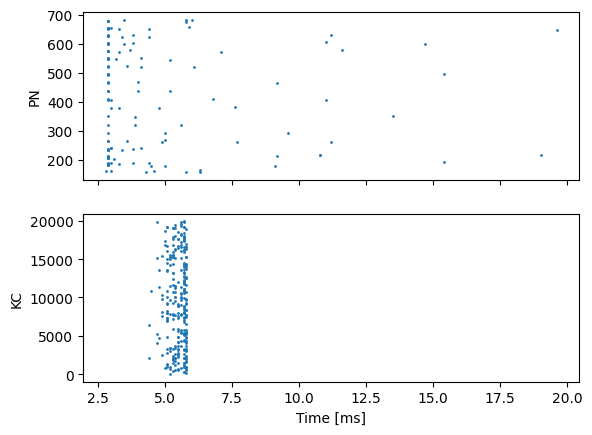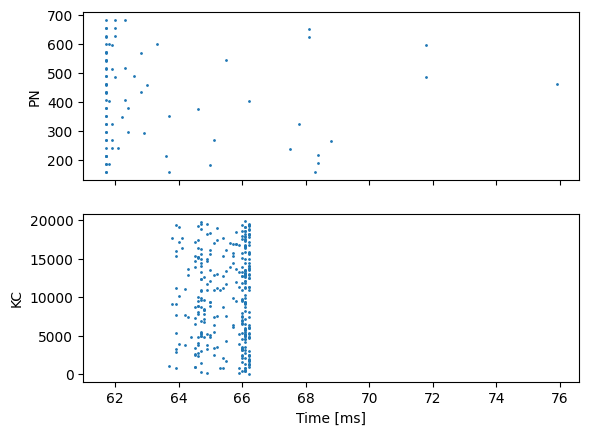Feedback-inhibition based gain control
Based on the highly variable levels of Kenyon Cell activity found in the last tutorial, here we add feedback inhibition inspired by the Giant GABAergic Neuron (GGN) found in Drosophila and, with this in place, visualize the spiking activity of Kenyon Cells in response to latency coded MNIST digits.
Install PyGeNN wheel from Google Drive
Download wheel file
[1]:
if "google.colab" in str(get_ipython()):
!gdown 1qlNCa_WT7sOmifYjPgGyggqUGsPiHn5y
!pip install pygenn-5.3.0-cp312-cp312-linux_x86_64.whl
%env CUDA_PATH=/usr/local/cuda
Downloading...
From: https://drive.google.com/uc?id=1wUeynMCgEOl2oK2LAd4E0s0iT_OiNOfl
To: /content/pygenn-5.1.0-cp311-cp311-linux_x86_64.whl
100% 8.49M/8.49M [00:00<00:00, 89.0MB/s]
Processing ./pygenn-5.1.0-cp311-cp311-linux_x86_64.whl
Requirement already satisfied: numpy>=1.17 in /usr/local/lib/python3.11/dist-packages (from pygenn==5.1.0) (1.26.4)
Requirement already satisfied: psutil in /usr/local/lib/python3.11/dist-packages (from pygenn==5.1.0) (5.9.5)
Requirement already satisfied: setuptools in /usr/local/lib/python3.11/dist-packages (from pygenn==5.1.0) (75.1.0)
pygenn is already installed with the same version as the provided wheel. Use --force-reinstall to force an installation of the wheel.
env: CUDA_PATH=/usr/local/cuda
Install MNIST package
[2]:
!pip install mnist
Collecting mnist
Using cached mnist-0.2.2-py2.py3-none-any.whl.metadata (1.6 kB)
Requirement already satisfied: numpy in /usr/local/lib/python3.11/dist-packages (from mnist) (1.26.4)
Using cached mnist-0.2.2-py2.py3-none-any.whl (3.5 kB)
Installing collected packages: mnist
Successfully installed mnist-0.2.2
Build tutorial model
Import modules
[3]:
import mnist
import numpy as np
from copy import copy
from matplotlib import pyplot as plt
from pygenn import (create_current_source_model, create_neuron_model, init_postsynaptic,
init_sparse_connectivity, init_weight_update, GeNNModel)
# Reshape and normalise training data
mnist.datasets_url = "https://storage.googleapis.com/cvdf-datasets/mnist/"
training_images = mnist.train_images()
training_images = np.reshape(training_images, (training_images.shape[0], -1)).astype(np.float32)
training_images /= np.sum(training_images, axis=1)[:, np.newaxis]
Parameters
Define some model parameters
[4]:
# Simulation time step
DT = 0.1
# Scaling factor for converting normalised image pixels to input currents (nA)
INPUT_SCALE = 80.0
# Number of Projection Neurons in model (should match image size)
NUM_PN = 784
# Number of Kenyon Cells in model (defines memory capacity)
NUM_KC = 20000
# How long to present each image to model
PRESENT_TIME_MS = 20.0
# Standard LIF neurons parameters
LIF_PARAMS = {
"C": 0.2,
"TauM": 20.0,
"Vrest": -60.0,
"Vreset": -60.0,
"Vthresh": -50.0,
"Ioffset": 0.0,
"TauRefrac": 2.0}
# We only want PNs to spike once
PN_PARAMS = copy(LIF_PARAMS)
PN_PARAMS["TauRefrac"] = 100.0
# Weight of each synaptic connection
PN_KC_WEIGHT = 0.2
# Time constant of synaptic integration
PN_KC_TAU_SYN = 3.0
# How many projection neurons should be connected to each Kenyon Cell
PN_KC_FAN_IN = 20
As we’re now going to be adding our synaptic connections between the Projection Neurons and a new population of Kenyon Cells, also define some parameter for these
[5]:
# We will use weights of 1.0 for KC->GGN connections and
# want the GGN to inhibit the KCs after 200 spikes
GGN_PARAMS = {
"Vthresh": 200.0}
Custom models
[6]:
# Current source model, allowing current to be injected into neuron from variable
cs_model = create_current_source_model(
"cs_model",
vars=[("magnitude", "scalar")],
injection_code="injectCurrent(magnitude);")
[7]:
# Minimal integrate and fire neuron model
if_model = create_neuron_model(
"IF",
params=["Vthresh"],
vars=[("V", "scalar")],
sim_code=
"""
V += Isyn;
""",
threshold_condition_code=
"""
V >= Vthresh
""",
reset_code=
"""
V = 0.0;
""")
Model definition
Create a new model called “mnist_mb_second_layer_gain_control” as before but add a second population of NUM_KC neurons to represent the Kenyon Cells.
[8]:
# Create model
model = GeNNModel("float", "mnist_mb_second_layer_gain_control")
model.dt = DT
# Create neuron populations
lif_init = {"V": PN_PARAMS["Vreset"], "RefracTime": 0.0}
pn = model.add_neuron_population("pn", NUM_PN, "LIF", PN_PARAMS, lif_init)
kc = model.add_neuron_population("kc", NUM_KC, "LIF", LIF_PARAMS, lif_init)
# Turn on spike recording
pn.spike_recording_enabled = True
kc.spike_recording_enabled = True
# Create current sources to deliver input to network
pn_input = model.add_current_source("pn_input", cs_model, pn , {}, {"magnitude": 0.0})
# Create synapse populations
pn_kc = model.add_synapse_population("pn_kc", "SPARSE",
pn, kc,
init_weight_update("StaticPulseConstantWeight", {"g": PN_KC_WEIGHT}),
init_postsynaptic("ExpCurr", {"tau": PN_KC_TAU_SYN}),
init_sparse_connectivity("FixedNumberPreWithReplacement", {"num": PN_KC_FAN_IN}))
Add a current source to inject current into pn using our newly-defined custom model with the initial magnitude set to zero.
[9]:
if_init = {"V": 0.0}
ggn = model.add_neuron_population("ggn", 1, if_model, GGN_PARAMS, if_init)
[10]:
kc_ggn = model.add_synapse_population("kc_ggn", "DENSE",
kc, ggn,
init_weight_update("StaticPulseConstantWeight", {"g": 1.0}),
init_postsynaptic("DeltaCurr"))
ggn_kc = model.add_synapse_population("ggn_kc", "DENSE",
ggn, kc,
init_weight_update("StaticPulseConstantWeight", {"g": -5.0}),
init_postsynaptic("ExpCurr", {"tau": 5.0}))
Build model
Generate code and load it into PyGeNN allocating a large enough spike recording buffer to cover PRESENT_TIME_MS (after converting from ms to timesteps)
[11]:
# Concert present time into timesteps
present_timesteps = int(round(PRESENT_TIME_MS / DT))
# Build model and load it
model.build()
model.load(num_recording_timesteps=present_timesteps)
Simulate tutorial model
As well as resetting the state of every neuron after presenting each stimuli, because we have now added synapses with their own dynamics, these also need to be reset. This function resets neuron state variables selected by the keys of a dictionary to the values specifed in the dictionary values and pushes the new values to the GPU.
Now, like before, we loop through 4 stimuli and simulate the model. However, now we need to reset the Projection Neuron and Kenyon Cell populations; and the synapses between them. Additionally, we want to show spikes from the Kenyon Cells as well as the Projection Neurons.
[12]:
def reset_out_post(pop):
pop.out_post.view[:] = 0.0
pop.out_post.push_to_device()
def reset_neuron(pop, var_init):
# Reset variables
for var_name, var_val in var_init.items():
pop.vars[var_name].view[:] = var_val
# Push the new values to GPU
pop.vars[var_name].push_to_device()
for s in range(4):
# Set training image
pn_input.vars["magnitude"].view[:] = training_images[s] * INPUT_SCALE
pn_input.vars["magnitude"].push_to_device()
# Simulate present timesteps
for i in range(present_timesteps):
model.step_time()
# Reset neuron state for next stimuli
reset_neuron(pn, lif_init)
reset_neuron(kc, lif_init)
reset_neuron(ggn, if_init)
# Reset synapse state
reset_out_post(pn_kc)
reset_out_post(ggn_kc)
# Download spikes from GPU
model.pull_recording_buffers_from_device();
# Plot PN and KC spikes
fig, axes = plt.subplots(2, sharex=True)
pn_spike_times, pn_spike_ids = pn.spike_recording_data[0]
kc_spike_times, kc_spike_ids = kc.spike_recording_data[0]
print(f"{len(np.unique(kc_spike_ids))} KC active")
axes[0].scatter(pn_spike_times, pn_spike_ids, s=1)
axes[0].set_ylabel("PN")
axes[1].scatter(kc_spike_times, kc_spike_ids, s=1)
axes[1].set_xlabel("Time [ms]")
axes[1].set_ylabel("KC")
plt.show()
281 KC active
274 KC active
247 KC active
331 KC active




Much better!